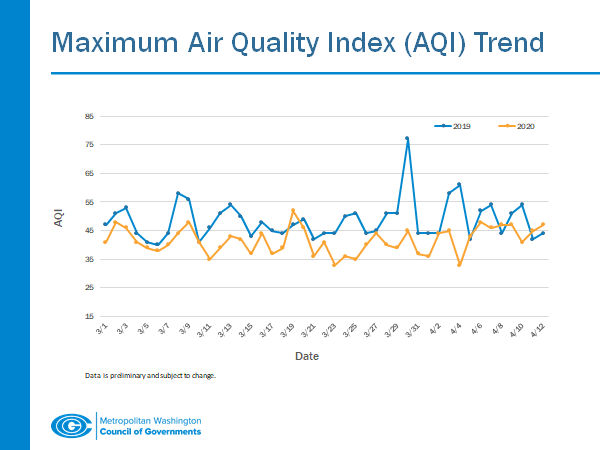As the region continues to #StayHomeDMV to slow the spread of COVID-19, many residents are heading outdoors to catch a "breath of fresh air." But just how clean is the air we are breathing?
The region's air quality has improved considerably over the past few decades, but data shows the region’s residents continue to breathe unhealthy air too frequently.
Stay-at-Home Orders and Air Quality
The Air Quality Index (AQI) is used to communicate how polluted the air is. Since the stay-at-home orders have been in place, the AQI is lower when compared to 2019.

But, how much of this can be attributed to measures taken to address COVID-19?
Reduced traffic, telework, and a decrease in energy consumption are certainly reducing emissions and helping to improve the air. Area departments of transportation report that vehicle traffic along major interstate highways is down 50 percent. The energy sector says electricity demand is down by 7 percent due to office and business closures. However, weather also plays a large role in the region's air quality. Air quality in metro Washington is typically good during the spring when the weather is cooler, so we do not yet have the full picture.
Eventually, COVID-19 restrictions will be lifted and pollution levels will likely rebound.
Air Quality and Your Health
Any amount of air pollution is unhealthy for those with pre-existing medical conditions, especially those with COVID-19, so it is critical that we continue to work together to improve the air.
We know that high levels of particles in the air can affect our lungs and heart, triggering asthma, bronchitis, emphysema, and cardiovascular disease, among other health problems. A recent study conducted by the Harvard T.H. Chan School of Public Health reports that air pollution weakens the immune system and fuels inflammation in the lungs and respiratory tract, adding to the risk of contracting severe cases of COVID-19.
Improving the Air During and Post-Pandemic
COG, in partnership with our region’s environmental departments, provides daily air quality forecasts, and continues to track the region’s air quality progress. Check out these resources and more at mwcog.org/airquality.
Clean Air Partners notes that there are many steps we can take from home to improve the air, protect health, and even save money now and in the future:
- When air quality is unhealthy, limit outdoor activity especially for sensitive groups.
- As it warms up, set your thermostat a few degrees higher to cut back on air conditioning and use a fan to keep cool.
- Use caulk/weather stripping to weatherproof your home and change heating and air conditioning filters every month.
- Turn off lights and appliances when not in use.
- Replace incandescent light bulbs with energy efficient CFLs or LED bulbs.
- Use power strips to reduce electricity use by shutting down power to devices in standby mode.
- Keep driving to a minimum. Telework, limit trips. Fill up your gas tank during evening hours.
- Postpone mowing and trimming on poor air quality days or use electric garden equipment.
- Check out these free online activities for children ages 5 to 15 to learn about the importance of clean air.
COG will continue to analyze data over the next months and years to help policymakers determine measures that can be implemented to protect public health and help the region meet federal air quality health standards.
Jennifer Desimone is COG's Air Quality Program Chief and Clean Air Partners Managing Director